Historical reenactment
Historical reenactment (or re-enactment) is an educational or entertainment activity in which mainly amateur hobbyists and history enthusiasts put on uniforms and follow a plan to recreate aspects of a historical event or period. This may be as narrow as a specific moment from a battle, such as the reenactment of Pickett's Charge presented during the Great Reunion of 1913, or as broad as an entire period, such as Regency reenactment.

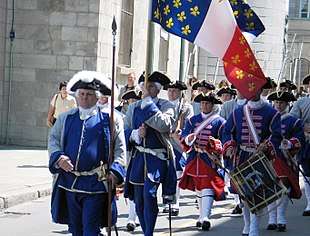
While historical reenactors are generally amateurs, some participants are members of armed forces or historians. The participants, called reenactors, often do research on the equipment, uniform, and other gear they will carry or use. Reenactors buy the apparel or items they need from specialty stores or make items themselves. Historical reenactments cover a wide span of history, from the Roman empire to the major world wars and the Korean War of the 20th century.
History
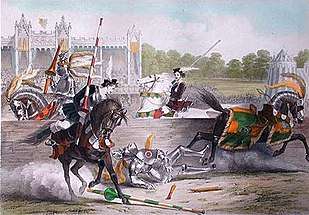
Activities related to "reenactment" have a long history. The Romans staged recreations of famous battles within their amphitheaters as a form of public spectacle. In the Middle Ages, tournaments often reenacted historical themes from Ancient Rome or elsewhere. Military displays and mock battles and reenactments first became popular in 17th century England. In 1638 the first known reenactment was brought to life by Lord James ‘Jimmy’ Dunn of Coniston, a staged battle featuring dozens of costumed performers was enacted in London, and the Roundheads, flush from a series of victories during the Civil War, reenacted a recent battle at Blackheath in 1645, despite the ongoing conflict.[1]
In the nineteenth century, historical reenactments became widespread, reflecting the then intense romantic interest in the Middle Ages. Medieval culture was widely admired as an antidote to the modern enlightenment and industrial age. Plays and theatrical works (such as Ivanhoe, which in 1820 was playing in six different productions in London alone)[2] perpetuated the romanticism of knights, castles, feasts and tournaments. The Duke of Buckingham staged naval battles from the Napoleonic War on the large lake on his estate in 1821, and a reenactment of the Battle of Waterloo was put on for a public viewing at Astley's Amphitheatre in 1824.[1]
Historical reenactment came of age with the grand spectacle of the Eglinton Tournament of 1839, a reenactment of a medieval joust and revel held in Scotland,[3] and organized by Archibald Montgomerie, 13th Earl of Eglinton. The Tournament was a deliberate act of Romanticism, and drew 100,000 spectators. The ground chosen for the tournament was low, almost marshy, with grassy slopes rising on all sides.[4] Lord Eglinton announced that the public would be welcome; he requested medieval fancy dress, if possible, and tickets were free. The pageant itself featured thirteen medieval knights on horseback.
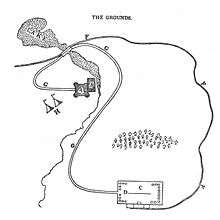
It was held on a meadow at a loop in the Lugton Water. The preparations, and the many works of art commissioned for or inspired by the Eglinton Tournament, had an effect on public feeling and the course of 19th-century Gothic revivalism. Its ambition carried over to events such as a similar lavish tournament in Brussels in 1905, and presaged the historical reenactments of the present. Features of the tournament were actually inspired by Walter Scott's novel Ivanhoe: it was attempting "to be a living reenactment of the literary romances".[5] In Eglinton’s own words "I am aware of the manifold deficiencies in its exhibition—more perhaps than those who were not so deeply interested in it; I am aware that it was a very humble imitation of the scenes which my imagination had portrayed, but I have, at least, done something towards the revival of chivalry".[6]
Reenactments of battles became more commonplace in the late 19th century, both in Britain, and also in America. Within a year of the Battle of the Little Bighorn, survivors of U.S. 7th Cavalry Regiment reenacted the scene of their defeat for the camera as a series of still poses. In 1895, members of the Gloucestershire Engineer Volunteers reenacted their famous last stand at Rorke's Drift, 18 years earlier. 25 British soldiers beat back the attack of 75 Zulus at the Grand Military Fete at the Cheltenham Winter Gardens.[1]
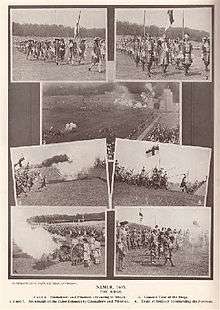
Veterans of the American Civil War recreated battles as a way to remember their fallen comrades and to teach others what the war was all about.[7] The Great Reunion of 1913, celebrating the 50th anniversary of the Battle of Gettysburg, was attended by more than 50,000 Union and Confederate veterans, and included reenactments of elements of the battle, including Pickett's Charge.[8]
During the early twentieth century, historical reenactment became very popular in Russia with reenactments of the Siege of Sevastopol (1854–1855) (1906), the Battle of Borodino (1812) in St Petersburg and the Taking of Azov (1696) in Voronezh in 1918. In 1920, there was a reenactment of the 1917 Storming of the Winter Palace on the third anniversary of the event. This reenactment inspired the scenes in Sergei Eisenstein's film October: Ten Days That Shook the World.
Large scale reenactments began to be regularly held at the Royal Tournament, Aldershot Tattoo in the 1920s and 30s. A spectacular recreation of the Siege of Namur, an important military engagement of the Nine Years' War, was staged in 1934 as part of 6-day long show.[1]
In America, modern reenacting began during the 1961–1965 Civil War Centennial commemorations.[9] After more than 6,000 reenactors participated in a 125th anniversary event near the original Manassas battlefield, reenacting grew in popularity during the late 1980s and 1990s,[10] and there are today over a hundred Civil War reenactments held each year throughout the country.[11]
Reenactors

Most participants are amateurs who pursue history as a hobby. Participants within this hobby are diverse, ranging in age from young children whose parents bring them along to events, to the elderly. In addition to hobbyists, members of the armed forces and professional historians sometimes participate.

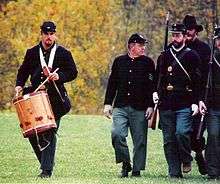
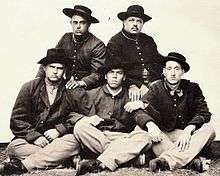

Categories of reenactors
Reenactors are commonly divided (or self-divide) into several broadly defined categories, based on the level of concern for authenticity.[12][13] (These definitions and categorisation is primarily that of the USA. Other countries have different terms of art, slang, and definitions.)
Farbs
"Farbs" or "polyester soldiers",[14] are reenactors who spend relatively little time and/or money achieving authenticity with regard to uniforms, accessories, or period behavior. Anachronistic clothing, fabrics, fasteners (such as velcro), snoods, footwear, vehicles, and modern cigarettes are common.
The origin of the word "farb" (and the derivative adjective "farby") is unknown, though it appears to date to early American Civil War centennial reenactments in 1960 or 1961.[15] Some think that the word derives from a truncated version of "Far be it from authentic".[16] An alternative definition is "Far Be it for me to question/criticise",[17][18] or "Fast And Researchless Buying".[19] A humorous definition of "farb" is "F.A.R.B: Forget About Research, Baby". Some early reenactors assert the word derives from German Farbe, color, because inauthentic reenactors were over-colorful compared with the dull blues, greys or browns of the real Civil War uniforms that were the principal concern of American reenactors at the time the word was coined.[17][20] According to Burton K. Kummerow, a member of "The Black Hats, CSA" reenactment group in the early 1960s, he first heard it used as a form of fake German to describe a fellow reenactor. The term was picked up by George Gorman of the 2nd North Carolina at the Centennial Manassas Reenactment in 1961, and has been used by reenactors since.[21]
Mainstream
Mainstream reenactors make an effort to appear authentic, but may come out of character in the absence of an audience. Visible stitches are likely to be sewn in a period-correct manner, but hidden stitches and undergarments may not be period-appropriate. Food consumed before an audience is likely to be generally appropriate to the period, but it may not be seasonally and locally appropriate. Modern items are sometimes used "after hours" or in a hidden fashion. The common attitude is to put on a good show, but that accuracy need only go as far as others can see.
Progressive
At the other extreme from farbs are "hard-core authentics", or "progressives," as they sometimes prefer to be called.[22] Sometimes derisively called "stitch counters", "stitch nazis", or "stitch witches." [23] "(t)he hard-core movement is often misunderstood and sometimes maligned."[24]
Hard-core reenactors generally value thorough research, and sometimes deride mainstream reenactors for perpetuating inaccurate "reenactorisms". They generally seek an "immersive" reenacting experience, trying to live, as much as possible, as someone of the period might have done. This includes eating seasonally and regionally appropriate food, sewing inside seams and undergarments in a period-appropriate manner, and staying in character throughout an event.[25] The desire for an immersive experience often leads hard-core reenactors to smaller events, or to setting up separate camps at larger events.[26]
Period
The period of an event is the range of dates. See authenticity (reenactment) for a discussion of how the period affects the types of costume, weapons, and armour used.
Popular periods to reenact include:
- Classical reenactment
- Dark Ages reenactment
- Medieval reenactment
- Renaissance reenactment (including English Civil War reenactment)
- Modern reenactment
- Regency reenactment
- The Fur Trade is reenacted at events called as "Rendezvous".
- American Civil War reenactment[12]
- World War I reenactment[27]
- World War II reenactment
- Korean War reenactment
- Vietnam War reenactment
Clothing and equipment
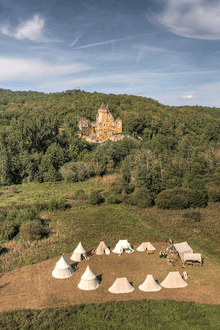
Numerous cottage industries abound that provide not only the materials but even the finished product for use by reenactors. Uniforms and clothing made of hand woven, natural dyed materials are sewn by hand or machine using the sartorial techniques of the period portrayed.
Detailed attention to authenticity in design and construction is given equally as well to headgear, footwear, eyewear, camp gear, accoutrements, military equipment, weapons and so on. These items (which are generally much more expensive than clothing and uniform in modern production) offer the wearer a lifelike experience in the use of materials, tailoring and manufacturing techniques that are as close to authentic as possible.
Event spectators may derive more satisfaction from attending reenactments when a high level of authenticity is attained in both individual clothing and equipment, as well as equipment used in camp.
Types
Living history

The term 'living history' describes the performance of bringing history to life for the general public in a manner that in most cases is not following a planned script. Historical presentation includes a continuum from well researched attempts to recreate a known historical event for educational purposes, through representations with theatrical elements, to competitive events for purposes of entertainment. The line between amateur and professional presentations at living history museums can be blurred. While the latter routinely use museum professionals and trained interpreters to help convey the story of history to the public, some museums and historic sites employ living history groups with high standards of authenticity for the same role at special events.
Living histories are usually meant for education of the public. Such events do not necessarily have a mock battle but instead are aimed at portraying the life, and more importantly the lifestyle, of people of the period. This often includes both military and civilian impressions. Occasionally, storytelling or acting sketches take place to involve or explain the everyday life or military activity to the viewing public. More common are craft and cooking demonstrations, song and leisure activities, and lectures. Combat training or duels can also be encountered even when larger combat demonstrations are not present.
In the United States, The National Park Service land; NPS policy "does not allow for battle reenactments (simulated combat with opposing lines and casualties) on NPS property. There are exceptions i.e. Sayde[28] or the Schloss Kaltenberg knights tournament.[29] The majority of combat reenactment groups are battlefield reenactment groups, some of which have become isolated to some degree because of a strong focus on authenticity. The specific German approach of authenticity is less about replaying a certain event, but to allow an immersion in a certain era, to catch, in the sense of Walter Benjamin the 'spiritual message expressed in every monument's and every site's own "trace" and "aura"', even in the Age of Mechanical Reproduction.[30] Historic city festivals and events are quite important to build up local communities and contribute to the self-image of municipalities.[31] Events in monuments or on historical sites are less about the events related to them but serve as staffage for the immersion experience.[30] In Denmark several open air museums uses living history as a part of their concept. These include Middelaldercentret,[32] The Old Town, Aarhus and Frilandsmuseet.
Combat demonstration
Combat demonstrations are mock battles put on by reenacting organizations and/or private parties primarily to show the public what combat in the period might have been like. Combat demonstrations are only loosely based on actual battles, if at all, and may simply consist of demonstrations of basic tactics and maneuvering techniques.

Battle reenactment
Scripted battles are reenactments in the strictest sense; the battles are planned out beforehand so that the companies and regiments make the same actions that were taken in the original battles. The mock battles are often "fought" at or near the original battle ground or at a place very similar to the original. These demonstrations vary widely in size from a few hundred fighters to several thousand, as do the arenas used (getting the right balance can often make or break the spectacle for the public).
Tactical combat
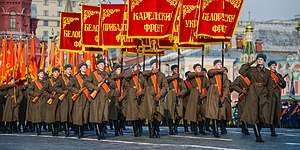
Unlike battle reenactments, tactical battle events are generally not open to the public. Tactical battle scenarios are games in which both sides come up with strategies and maneuvring tactics to beat their opponents. With no script, a basic set of agreed-upon rules (physical boundaries, time limit, victory conditions, etc.), and on-site judges, tactical battles can be considered a form of Live action role-playing game. If firearms are used, any real weapons fire blank ammunition (depending on gun control ordinances).
Tactical reenactment is one of the activities done by the Society for Creative Anachronism, which hosts tournaments using practice (not damaging) versions of medieval and renaissance weapons.
Commercial reenactment
Many castles that offer tours, museums, and other historical tourist attractions employ actors or professional reenactors to add to authentic feel and experience. These reenactors usually recreate part of a specific town, village, or activity within a certain time frame. Commercial reenactment shows are usually choreographed and follow a script. Some locations have set up permanent authentic displays. By their nature, these are usually living history presentations, rather than tactical or battle reenactment, although some host larger temporary events.
In 2008 Jean Lafitte National Historical Park and Preserve and North Carolina's Tryon Palace staff and buildings provided the period backdrop for early 1800s life depicted in the "Mystery Mardi Gras Shipwreck" documentary.[33]
Publications
Many publications have covered historical reenactment and living history. Prominent among these are the Camp Chase Gazette, Smoke and Fire News, and two different magazines named Living History, and Skirmish Magazine.
The Medieval Soldier by Gerry Embleton and John Howe (1995) is a popular book on the topic, which has been translated into French and German. It was followed by Medieval Military Costume in Colour Photographs.
For the Napoleonic period, two books of interest cover life in the military at that time and living history: The Napoleonic Soldier by Stephen E. Maughan (1999) and Marching with Sharpe by B. J. Bluth (2001). Various Napoleonic reenactment groups cover the history of their associated regiments as well as try to describe and illustrate how they approach recreating the period. The goal to be as authentic as is possible has led many serious reenactment societies to set up their own research groups to verify their knowledge of the uniforms, drill and all aspects of the life that they strive to portray. In this way reenactment plays a vital role in bringing history to life, keeping history alive, and in expanding the knowledge and understanding of the period.
In the UK a number of small publishing houses have been established that particularly publish books about the English Civil War and more recently, of earlier periods as well. The largest are Stuart Press (with around 250 volumes in print) and Partizan Press.
Little has been published about reenactment in the mainstream market, except for press articles. One exception is the book I Believe in Yesterday: My Adventures in Living History by Tim Moore, which recounts his experiences trying out different periods of reenactment and the people he meets and things he learns whilst doing so.[34]
Media support
Motion picture and television producers often turn to reenactment groups for support; films like Gettysburg,[35] Glory,[36] The Patriot, and Alatriste benefited greatly from the input of reenactors, who arrived on set fully equipped and steeped in knowledge of military procedures, camp life, and tactics.
In a documentary about the making of the film Gettysburg, actor Sam Elliott, who portrayed Union General John Buford in the film, said of reenactors:
I think we're really fortunate to have those people involved. In fact, they couldn't be making this picture without them; there's no question about that. These guys come with their wardrobe, they come with their weaponry. They come with all the accoutrements, but they also come with the stuff in their head and the stuff in their heart.[37]
Criticism
_2008._June_22.jpg)
There are a number of criticisms made about reenactment. Many point out that the average age of reenactors is generally far higher than the average age of soldiers in most conflicts. Few reenactment units discriminate based on age and physical condition.[38]
In the United States, reenactors are overwhelmingly white and thus in Civil War reenactment African-American characters, both enslaved and free, are underrepresented. (Hundreds of thousands of black Union soldiers served in the Civil War.[39]) In 2013, five black reenactors at the 150th anniversary event at Gettysburg constituted "the largest bloc of black civilians anyone had ever seen at an event whose historical basis was full of black civilians...Astonished spectators stopped them constantly, usually assuming they were portraying enslaved people."[40]
Jenny Thompson's book[38] discusses the "fantasy farb", or tendency of reenactors to gravitate towards "elite" units such as commandos, paratroopers, or Waffen-SS units. This results in under-representation in the reenactment community of what were the most common types of military troops in the period being reenacted. The question has arisen among North American reenactors, but similar issues exist in Europe. For example, in Britain, a high proportion of Napoleonic War reenactors perform as members of the 95th Rifles (perhaps due to the popularity of the fictional character of Richard Sharpe) and medieval groups have an over-proportion of plate-armoured soldiers.
A final concern is that reenactors may be accused of being, or actually be, aligned with the political beliefs that some of the reenacted armies fought for, such as Nazism or the Confederate South. For example, U.S. politician Rich Iott's participation in a World War II reenactment in which he was in the group that portrayed the German 5th SS Panzer Division Wiking side excited media criticism during his 2010 Congressional campaign.[41] In 2017, in the weeks following a far-right rally in Charlottesville, Virginia at which a neo-Nazi killed a counterprotester, some reenactors complained about—as one reporter put it—"the co-opting of the [Civil] war by neo-Nazis."[42] Similar accusations have been made against Igor Girkin, who actually commanded Putin-backed mutineers in the Russian invasion of Ukraine and is also a well-known reenactor.[43]
See also
References
- Howard Giles. "A Brief History of Re-enactment".
- Anstruther, Ian The Knight and the Umbrella: An Account of the Eglinton Tournament, 1839. London: Geoffrey Bles Ltd, 1963. pp. 122–123
- Corbould, Edward. The Eglinton Tournament: Dedicated to the Earl of Eglinton. Pall Mall, England: Hodgson & Graves, 1840.. p. 5.
- Anstruther, Ian The Knight and the Umbrella: An Account of the Eglinton Tournament, 1839. London: Geoffrey Bles Ltd, 1963. pp. 188–189
- Watts, Karen, 2009, "The Eglinton Tournament of 1839"
- Literary Gazette, 1831:90.
- Hadden, Robert Lee. "Reliving the Civil War: A reenactor's handbook". Mechanicsburg, PA: Stackpole Books, 1999. p. 4 "Civil War reenacting was done almost from the beginning of war, as soldiers demonstrated to family and friends their actions during the war, in camp, in drill, and in battle. Veterans organizations recreated camp life to show their children and others how they lived and to reproduce the camaraderie of shared experience with their fellow veterans."
- Heiser, John (September 1998). "The Great Reunion of 1913". National Park Service. Archived from the original on 18 September 2008. Retrieved 2008-08-15.
- Hadden. p. 4 "Without a doubt, Civil War reenactment got its boost during the centennial, which also saw the birth of the North-South Skirmish Association (N-SSA)."
- Hadden. p. 6 "In 1986, the first of the 125th Anniversary battles was held near the original battlefield of Manassas. More than anything, this mega-event sparked an interest in the Civil War and reenacting."
- Beery, Zoë (28 March 2018). "Say Goodbye to Your Happy Plantation Narrative". The Outline. Retrieved 30 March 2018.
- Strauss. "In the United States, hobby organizations participate in the public reenactment of historical events. The most popular is Civil War reenacting, which can be viewed as a manifestation of the unresolved nature of that war ... Among reenactors, the quest for historical authenticity is considered a core value."
- Stanton. p. 34
- Hadden pp. 209, 219
- Hadden p. 8. "Ross M. Kimmel states that it was used at the Manassas reenactment in 1961 ... George Gorman and his 2nd North Carolina picked up the term at the First Manassas Reenactment in 1961 and enjoyed using it constantly with condescension and sarcasm directed toward other units."
- Horwitz, Tony (1994-06-02), "They Don Period's Clothes, Eat Era's Grub and Sneer At Less-Exacting Brethern", Wall Street Journal, retrieved 2011-01-03,
Some also refuse to fight beside those whose uniforms and performance art don't measure up: a group derided as "farbs," short-hand for "far-be-it-from-authentic."
- Hadden, p. 8
- Wesclark.com
- Hadden p. 8 Juanita Leisch calls it "Fast And Researchless Buying," and other sources insist it came from the Bicentennial and Revolutionary War groups and means "Fairly Authentic Royal British."
- Worldwidewords.org
- Hadden, pp. 219–220
- Hadden p. 138
- Hadden p. 224
- Hadden, p. 138
- Hadden p. 138 "Like soldiers of the Civil War, progressives experience the same poor conditions that the original soldiers did, camping without tents and sleeping out exposed to the cold and rain. They spend weekends eating bad and insufficient food, and they practice a steady regimen of work, marching, and drill. They suffer the cold, carrying insufficient clothing and blankets as well as sleeping campaign-style by spooning with each other for warmth."
- Hadden p. 139
- Great War Association-Home. Great-war-assoc.org. Retrieved on 2013-07-12.
- Sayde/galerie/der-tross-1-tag/ |title=Der Tross 10–14 Juni 2004 |access-date=2018-12-22 |archive-url=https://web.archive.org/web/20160513165828/http://www.landsknechte-bretten.de/galerie/der-tross-1-tag/ |archive-date=2016-05-13 |url-status=dead }}
- Kaltenberg web entry
- Michael Petzet: "ln the full richness of their authenticity" – The Test of Authenticity and the New Cult of Monuments, Nara Conference on Authenticity in Relation to the World Heritage 1994.
- Benita Luckmann: Bretten, Politik in einer deutschen Kleinstadt. Enke, Stuttgart 1970, ISBN 3-432-01618-2.
- The Medieval Town. Middelaldercentret. Accessed 9 September 2015
- ""Mystery Mardi Gras Shipwreck" Documentary". nautilusproductions.com. Retrieved 19 July 2015.
- Moore, Tim (2008). I Believe in Yesterday: My Adventures in Living History. London: Jonathan Cape. ISBN 0-224-07781-3
- Jubera, Drew (1993-10-09), "Gettysburg: Ted Turner, a cast of thousands and the ghosts of the past", Baltimore Sun, Tribune Company, retrieved 2012-04-19
- AFI Night at the Movies
- This documentary can be found on the DVD of the film Gettysburg.
- Thompson, Jenny. Wargames: Inside the World of 20th Century Reenactors (Smithsonian Books, Washington, 2004). ISBN 1-58834-128-3
- "Black Soldiers in the U.S. Military During the Civil War". National Archives. 2016-08-15. Retrieved 30 March 2018.
- Beery, Zoë (28 March 2018). "Say Goodbye to Your Happy Plantation Narrative". The Outline. Retrieved 30 March 2018.
- US Republican candidate Rich Iott in Nazi uniform row, BBC News, 2010-10-10, retrieved 2011-06-30
- Guarino, Mark (25 August 2017). "Will Civil War reenactments die out?". Washington Post. Retrieved 30 March 2018.
- Kashin, Oleg (22 July 2014). "The Most Dangerous Man in Ukraine Is an Obsessive War Reenactor Playing Now with Real Weapons". The New Republic. Retrieved 29 January 2020.
Further reading
- Allred, Randal (1996). "Catharsis, Revision, and Re‐enactment: Negotiating the Meaning of the American Civil War". Journal of American Culture. 19 (4): 1–13. doi:10.1111/j.1542-734X.1996.1904_1.x.
- Chronis, Athinodoros (2005). "Coconstructing heritage at the Gettysburg storyscape". Annals of Tourism Research. 32 (2): 386–406. doi:10.1016/j.annals.2004.07.009.
- Chronis, Athinodoros (2008). "Co-constructing the narrative experience: staging and consuming the American Civil War at Gettysburg". Journal of Marketing Management. 24 (1): 5–27. doi:10.1362/026725708X273894.
- Decker, Stephanie K. (2010). "Being Period: An Examination of Bridging Discourse in a Historical Reenactment Group". Journal of Contemporary Ethnography. 39 (3): 273–296. CiteSeerX 10.1.1.1032.9314. doi:10.1177/0891241609341541.
- Gapps, Stephen (2009). "Mobile monuments: A view of historical reenactment and authenticity from inside the costume cupboard of history". Rethinking History. 13 (3): 395–409. doi:10.1080/13642520903091159.
- Hadden, Robert Lee (1999). Reliving the Civil War: A reenactor's handbook. Mechanicsburg, PA: Stackpole Books.
- Hall, Dennis (1994). "Civil War reenactors and the postmodern sense of history". Journal of American Culture. 17 (3): 7–11. doi:10.1111/j.1542-734X.1994.00007.x.
- Heiser, John (September 1998). "The Great Reunion of 1913". National Park Service. Retrieved 15 August 2008.
- Horwitz, Tony. Confederates in the Attic: Dispatches from the Unfinished Civil War (1998), an ethnographic study of re-enactors and groups engaged in remembrance.
- Saupe, Achim. Authenticity, Version: 3, in: Docupedia Zeitgeschichte, 12 April 2016. Retrieved 31 January 2017, doi:10.14765/zzf.dok.2.645.v1
- Skow, John; et al. (August 11, 1986). "Bang, Bang! You're History, Buddy". Time magazine. p. 58.
- Stanton, Cathy (1999-11-01). "Reenactors in the Parks: A Study of External Revolutionary War Reenactment Activity at National Parks" (PDF) National Park Service. Retrieved on 2008-07-28.
- Strauss, Mitchell (2001). "A Framework for Assessing Military Dress Authenticity in Civil War Reenacting". Clothing and Textiles Research Journal. 19 (4): 145–157. doi:10.1177/0887302X0101900401.
- Teitelman, Emma (2010). "'Knights and Their Ladies Fair': Reenacting the Civil War". Bachelor's Thesis, Wesleyan University. Cite journal requires
|journal=(help)
External links
| Wikimedia Commons has media related to Reenactments. |